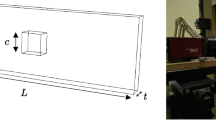Abstract
Results of static fracture tests on PMMA plates with part-elliptical cracks at fastener holes are presented. Experimental configurations include three crack locations with respect to both open and loaded holes. During static testing, slow growth prior to specimen separation allows for calculation of the maximum stress-intensity factor and identification of the location on the crack border at which it occurs. The testing techniques developed produce a simple, economical means of experimentally validating theoretical analyses of crack problems.
Similar content being viewed by others
Abbreviations
- AK ic :
-
apparent fracture toughness
- a,c :
-
crack semi-axes (described in Fig. 1)
- b :
-
crack minor axis
- d :
-
hole diameter
- K 1 :
-
Mode-one stress-intensity factor
- K IC :
-
fracture toughness
- M 1 :
-
front-surface correction factor
- M 2 :
-
back-surface correction factor
- MF :
-
magnification factor
- P :
-
applied load
- Q/P :
-
load-transfer ratio
- t :
-
plate thickness
- w :
-
plate width
- σ:
-
remote mean normal stress,\(\sigma = \frac{P}{{wt}}\)
- σ b :
-
fastener-hole bearing stress,\(\sigma _b = \frac{P}{{dt}}\)
- σ ys :
-
yield strength
- β:
-
angle around fastener hole, measured from the crack plane
- ϕ:
-
crack-shape parameter; the complete elliptic integral of the second kind
References
Kullgren, T.E., Smith, F.W. andGanong, G.P., “Quarter Elliptical Cracks Emanating from Holes in Plates,”J. of Engrg. Matls. and Tech.,100 (2),144–149 (Apr. 1978).
Kullgren, T.E. andSmith, F.W., “Part Elliptical Cracks Emanating from Open and Loaded Holes in Plates,”J. Engrg. Matls. and Tech.,101 (1),12–17 (Jan. 1979).
Smith, F.W. and Kullgren, T.E., “Theoretical and Experimental Analysis of Surface Cracks Emanating from Fastener Holes,” Technical Report AFFDL-TR-76-104, Air Force Flight Dynamics Laboratory, Wright-Patternson AFB, OH, 111–152 (1977).
Snow, J.R., “A Stress Intensity Factor Calibration for Corner Flaws at an Open Hole,”Technical Report AFML-TR-74-282, Air Force Materials Laboratory, Wright-Patterson AFB, OH (1975).
McGowan, J.J. and Smith, C.W., “Stress Intensity Factors for Deep Cracks Emanating from the Corner Formed by a Hole Intersecting a Plate Surface”, Technical Report VPI-E-74-1, Virginia Polytechnic Institute and State University (1974).
Jones, M.H. and Brown, U.F., “The Influence of Crack Length and Thickness in Plane Strain Fracture Toughness Tests,” Review of Developments in Plane Strain Fracture Toughness Testing, ASTM Special Technical Publication 463 (1970).
Smith, F.W. and Alavi, M.J., “Stress Intensity Factor for a Part-Circular Surface Flaw,” Proceedings of the First International Conference on Pressure Vessel Technology, Delft, Holland (1969).
Smith, F.W. andSorensen, D.R., “Mixed Mode Stress Intensity Factor for Semi-Elliptical Surface Cracks,”Technical Report No. 5, NASA Grant NGL-06-0020063, Colorado State University, Fort Collins, CO (1974).
Shah, R.C. and Kobayashi, A.S., “Stress Intensity Factors for an Elliptical Crack Approaching the Surface of a Semi-Infinite Solid,” Intnl. J. of Fract.,9 (2 (1973).
Smith, F.W., “Stress Intensity Factors for a Surface Flawed Fracture Specimen,”Technical Report No. 1, NASA Grant MGR-06-002-063, Colorado State University, Fort Collins, CO (Sept. 1971).
Brown, W.F., Jr. and Srawley, J.E., “Fracture Toughness Testing Methods,” Fracture Toughness Testing and its Applications, ASTM Special Technical Publication 381 (1965).
Irwin, G.R., “Fracture Testing of High Strength Sheet Materials Under Conditions Appropriate for Stress Analysis,” Report 5486, United States Naval Research Laboratory (July 1960).
Author information
Authors and Affiliations
Rights and permissions
About this article
Cite this article
Kullgren, T.E., Smith, F.W. Static fracture testing of PMMA plates having flawed fastener holes. Experimental Mechanics 20, 95–102 (1980). https://doi.org/10.1007/BF02321234
Received:
Revised:
Issue Date:
DOI: https://doi.org/10.1007/BF02321234




